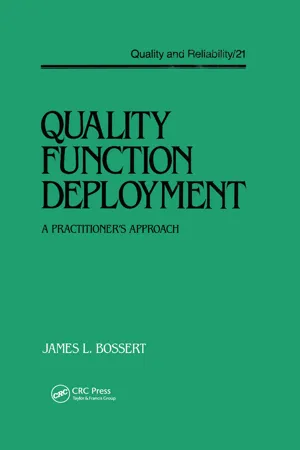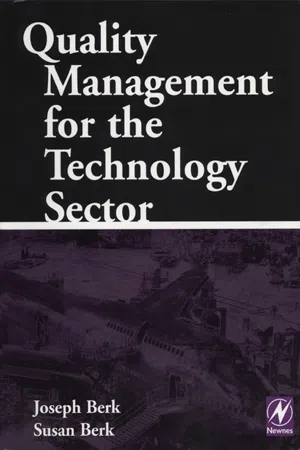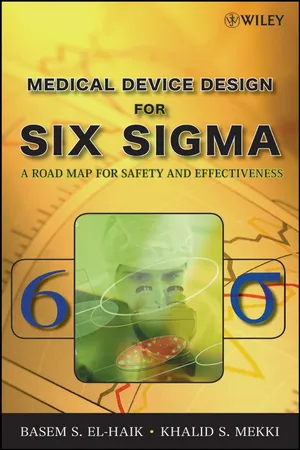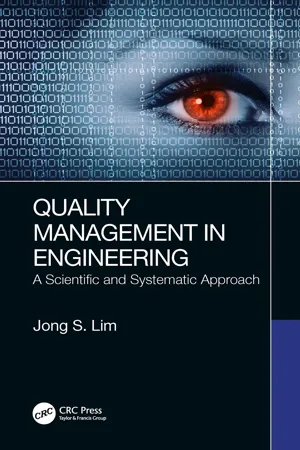Technology & Engineering
Quality Function Deployment
Quality Function Deployment (QFD) is a systematic method for translating customer requirements into specific engineering characteristics and quality control points. It aims to ensure that the final product or service meets or exceeds customer expectations. QFD involves cross-functional teams and the use of matrices to prioritize customer needs and align them with design and production processes.
Written by Perlego with AI-assistance
Related key terms
Related key terms
1 of 4
Related key terms
1 of 3
11 Key excerpts on "Quality Function Deployment"
- eBook - ePub
Quality Function Deployment
The Practitioner's Approach
- Bossert(Author)
- 2021(Publication Date)
- CRC Press(Publisher)
PART ONE 1 What Is Quality Function Deployment? When first approached about Quality Function Deployment (QFD), most managers question what it is. Quality Function Deployment, or QFD as it is commonly known, is a process that provides structure to the development cycle. This structure can be likened to the framework of a house. The foundation is customer requirements. The frame consists of the planning matrix, which includes items such as the importance rating, customer-perceived benchmarking, sales point, and scale-up factors. The second floor of the house includes the technical features. The roof is the trade-off of technical features. The walls are the interrelationship matrix between the customer requirements and the technical characteristics. Other parts can be built using things such as new technologies, functions, technical characteristics, processing steps, importance ratings, competitive analysis, and sales points. The components utilized are dependent upon the scope of the project. The thing that makes QFD unique is that the primary focus is the customer requirements. The process is driven by what the customer wants, not by innovations in technology. Consequently, more effort is involved getting the information necessary for determining what the customer truly wants. This tends to increase the initial planning time in the project definition phase of the development cycle, but it reduces the overall cycle time in bringing a product to market. This is illustrated in Figure 1, which is reproduced with permission from GOAL/QPC. When a product is conceived, the primary focus is on who the customer is, since the customer sets the stage for all the work. What the customer wants will determine whether new technologies are needed, whether simple improvements are possible, or whether a revolutionary concept is required. Success in determining customer requirements is directly related to success in the marketplace - eBook - ePub
Quality Function Deployment and Systems Supportability
Achieving Key Performance Parameters and Ensuring Functional Alignment
- John Longshore, Angela Cheatham, Jim Gibson(Authors)
- 2023(Publication Date)
- Productivity Press(Publisher)
1Passage contains an image
Chapter 1 Quality Function Deployment; Its Origins and Objectives
DOI: 10.4324/9781003336044-2Quality Function Deployment Defined
What do we mean when we use the word “Quality”? As an adjective, Quality means “excellent.” Because the customer expectations determine quality, you cannot have a quality product or service without first identifying your customers and then defining “What” their needs and expectations are. The second word Function, as a verb, means “to work or operate in a proper or particular way.” This means “How” customers’ expectations will be met or how the product or service will function to meet them. Finally, Deployment defines how you will manage the flow of development efforts to make certain customers’ expectations drive the product or service effort.Quality Function Deployment (QFD) is a planning and management quality process tool that drives optimal product and service development. It is a structured product or service planning method that enables development teams to specify a customer’s needs clearly. It then can be used to systemically evaluate the products or services capabilities in terms of impact on those identified needs. A key benefit of QFD, because of its structural design, is that it assists product development teams in communicating to decision makers exactly “What” needs to be developed and “How” it needs to be developed. It allows organizations to evaluate early on in the conceptual stage of the product or service development lifecycle whether it is worth the investment.1 , 2Figure 1.1Quality Function Deployment VOC Needs Capture and Verification.The QFD process tends to vary from practitioner to practitioner. However, one constant element required by all QFD efforts is an accurate assessment of the customer’s needs. This process begins with listening to the voice of the customer (VOC), gathering information on the identified needs, and ends with validating those needs. An illustration of this front-end work is provided in Figure 1.1 .3 - eBook - ePub
The Organization and Management of Construction
Managing the construction enterprise
- David Langford, Arkady Retik(Authors)
- 2012(Publication Date)
- Routledge(Publisher)
“Japanese companies using QFD have achieved notable improvement in the design-development process:- engineering changes have been reduced 30% to 50%.
- design cycle has been shortened 30% to 50%.
- start-up costs have been reduced 20% to 60%.
QFD also has a positive impact on the product itself.- increased customer satisfaction and market share.
- improved designs and performance.
- reduced warranty claims (as much as 50%)” (5 ).
Customer information gathering takes time, therefore, product definition or feasibility takes longer when using QFD, however, the design period is shortened and redesign is said to be almost eliminated.3 What is QFD?
The Japanese meaning for deployment is “an extension or broadening of activities” (6 ) and quality function refers “to any activity needed to assure quality is achieved” (7 ). Therefore, Quality Function Deployment means that quality is the responsibility of all those within the organisation. Stated in this fashion QFD could be confused with TQM. Akao (8 ) defines QFD as “a method for developing a design quality aimed at satisfying the consumer and then translating the consumer demands into design targets and major quality assurance points to be used throughout the production stage”. Therefore, QFD can be described as the operational definition of TQM, the system behind the philosophy.QFD forms the framework that ties all the activities of a company into one complete harmonised customer orientated package. The complete product development process is driven by what the customer genuinely wants, not what the designers think they want, nor is it driven by innovations in technology. “If there is a low-tech, low-cost way of satisfying the customer, it should be used”(9 - eBook - ePub
- Joseph Berk, Susan Berk(Authors)
- 2000(Publication Date)
- Butterworth-Heinemann(Publisher)
“That’s not the right approach,” Levenson said. The rest of the engineers and physicists in the room fell silent. Levenson continued. “If there are conflicts in what the laser has to do, we can’t make the tradeoffs independently and then tell the customer to take it or leave it. Our company got where it is today by being responsive to the customer. We’re the number one developer and producer of military lasers in the world. We’re in that position because our customers prefer us, and they prefer us for a lot of reasons. One reason is our technical expertise, which comes from the people in this room and others across the hall and out in the factory. Another reason, though, is that we meet the customer’s needs. Our problem here is that this is the first time the customer has levied a set of requirements on us that seem to be in conflict with each other. Our challenge is to put our minds into this job, with the customer, and determine which requirements are most important and which requirements can be relaxed.”Quality Function Deployment
Quality Function Deployment (or QFD, for short) is a basic TQM tool that systematically develops customers’ needs and expectations. The tool provides a graphical methodology for unearthing a customer’s stated and unstated needs and expectations, for making decisions in cases where these needs and expectations conflict, and for driving these customer-based requirements and expectations into the product development and manufacturing process. QFD is driven by what the customer wants, and for this reason, the technique is often described as “deploying the voice of the customer.”QFD originated in the late 1960s and early 1970s in Japan, when the Mitsubishi Corporation developed it for defining shipbuilding requirements at the Kobe Shipyards. Building ships involves enormous expenses and a small number of products. For these reasons, Mitsubishi recognized the importance of determining in great detail exactly what their ship-buying customers wanted before beginning the design process.Mitsubishi recognized many other factors that could influence their ship-buying customers’ needs and expectations. Potential conflicts between customer-expressed requirements (the situation described earlier on the PAVE VIPER laser program) would influence customer needs and expectations. Requirements the customer might not express (or perhaps might not even recognize, but requirements the customer would want satisfied nonetheless) would influence the design process. These requirements might include expectations so basic they might not have even entered the customer’s requirements-listing thought process. It almost goes without saying that ships shouldn’t leak. Because this is such an obvious requirement, a watertight hull would probably not be listed as a customer requirement, but the requirement exists. Another group of requirements the customer might list include such things as government regulations, and perhaps other externally imposed requirements. - eBook - ePub
- William L. Chapman, A. Terry Bahill, A. Wayne Wymore(Authors)
- 2018(Publication Date)
- CRC Press(Publisher)
chapter seven Other system design tools In this chapter, we discuss other tools and techniques used by system designers. The sections of this chapter are independent of one another and need not be examined in order. 7.1 Quality Function Deployment (QFD)Over the past 40 years, the Japanese have developed many quality improvement techniques for manufacturing processes. One of these, Quality Function Deployment (QFD), is becoming very popular in both Japan and the United States. QFD was developed in Japan in the late 1960s and is now used by half of Japan’s major companies. Automobile manufacturing companies in the United States began using the tool in the early 1980s. Now many major corporations use it, including John Deere, Ford, Chrysler, General Motors, Hughes Aircraft, Boeing, McDonnell Douglas, Martin Marietta, Texas Instruments, and 3M.The objective of QFD is to get the idea of quality introduced into the early phases of the design cycle and maintained throughout the entire life cycle of the product. In most implementations, QFD requires the use of many matrixlike charts (called Houses of Quality) to discover interrelationships among customer demands, engineering requirements, and manufacturing processes, as shown in Figure 7.1 . For example, the first QFD chart compares the customer demands to quality characteristics. The second chart investigates the relationships between these quality characteristics and characteristics of the product. The third chart looks for relationships between product characteristics and characteristics of the manufacturing system. Finally, these manufacturing characteristics are related to the quality controls that will be monitored during manufacture. This process of studying interrelationships may continue through dozens of charts.The Japanese concept is that everyone should participate in making the product better. (This sounds like a renaming of systems engineering.) Therefore, QFD data is presented in a user-friendly format—all system design tools should be usable by the Ph.D. chief scientist as well as the janitor lacking a high school diploma. Thus, QFD tools must be mathematically simple. - eBook - ePub
Medical Device Design for Six Sigma
A Road Map for Safety and Effectiveness
- Basem El-Haik, Khalid S. Mekki(Authors)
- 2011(Publication Date)
- Wiley-Interscience(Publisher)
8 Quality Function Deployment 8.1 INTRODUCTIONIn this chapter we cover the history of Quality Function Deployment (QFD; see El-Haik, 2007), describe the methodology of applying the QFD within the DFSS project road map (Chapter 7), and apply QFD to a medical device example. QFD is a planning tool that allows the flow-down of high-level customer needs and wants, a major component of design inputs, through to design parameters and then to process variables critical to fulfilling the high-level needs. By following the QFD methodology, relationships are explored between quality characteristics expressed by customers and substitute quality requirements expressed in engineering terms (Cohen, 1988, 1995). In the context of medical device DFSS, we call these requirements critical-to characteristics . These characteristics can be expanded along the dimensions of safety (critical to safety ), quality (critical to quality ) and cost (critical to cost ), as well as the other dimensions. In the QFD methodology, customers define their wants and needs using their own expressions, which rarely carry any actionable engineering technical terminology. The voice of the customer can be affinitized into a list of needs and wants that can be used as input to a relationship matrix, which is called QFD’s house of quality .Knowledge of customer needs and wants is paramount in designing effective products and services with innovative and rapid means. Utilizing the QFD methodology allows the developer to attain the shortest development cycle while ensuring the fulfillment of customer needs and wants.Figure 8.1Figure 8.1 Time-phased effort for DFSS versus traditional design. - eBook - ePub
- K. L. Richards(Author)
- 2020(Publication Date)
- CRC Press(Publisher)
Maintain channels of communication throughout the design change process in order to minimise the delays in getting the formal sign off for the change.Despite all these notes, we are firmly advocating the need to initiate and follow a process. Failing to do so creates the opportunity for an organisation to incur significant risks in the form of costs, programme, H&S or environment, all of which are liable not only to damage reputation, but also to undermine businesses, and in the worst cases, destroy lives.11.7 Quality Function Deployment11.7.1 IntroductionQuality Function Deployment (QDF) was first developed in Japan by Yoji Akao in the late 1960s when working for Mitsubishi’s Shipyards. It was later adopted by other companies including Toyota and its supply chain. In the early 1980s, QFD was introduced in the United States mainly by the big three automotive companies and a few electronics manufacturers. Its acceptance in the United States was rather slow to begin with but has since gained popularity and is currently being used in a number of industries including manufacturing, healthcare and service organisations.The central core of the method is the Voice of the Customer (VOC) in which the design quality and customer-perceived value are actively integrated into the product.These companies are utilising a structured process to define their customer’s wants and needs and transforming them into specific product designs and process plans to produce products that fulfil the customer’s requirements.11.7.2 What is QFD?QFD is a structured process with a set of tools that is used to effectively define customer requirements and convert them into detailed engineering specifications and plans to produce the products that fulfil those requirements. QFD is used to translate customer requirements into measureable design targets and drive them from the assembly level down through the sub-assembly, component and production process levels. The methodology provides a defined set of matrices utilised to facilitate this progression. - eBook - ePub
- Paul Hayes(Author)
- 2020(Publication Date)
- Business Expert Press(Publisher)
CHAPTER 11Deployment for Quality
Early in the 1980s it became clear that Japan had leap-frogged the United States and many other developed countries in providing high-quality products. The videos and the messages that were promoted by the government were quite blunt—Japan was quite happy to share all they had learned—originally from the West, because they didn’t believe we would apply it and regain our competitive position in the West.There were many names and flavours for the best practice in Japan— total quality control (TQC) and company wide quality control (CWQC) but the most important, that now plays a central role worldwide in 6-sigma (see Chapter 16 Six sigma) is Quality Function Deployment (QFD) a technique first developed in Japan.Quality Function Deployment (QFD)
The benefit of having different cultures view and examine best practice from a radically different perspective is that there is a likelihood of significant innovation. This happened when Japan, which had been a closed society in the 18th century, completed its emergence in World War II and lost. Out of the help that the United States gave Japan came a manufacturing renaissance and among the innovations came the most thoroughgoing application of process to the manufacturing and service industries.QFD is definitive, clear, and complex. The technique took shape at the Kobe Shipyard of Mitsubishi Heavy Industries Ltd in Japan in the early 1970s and the term “deployment” in Japanese implies an extension or broadening that encompasses the whole of the organization.1The enormous strength of QFD is organization and processwide integration of customer requirements down to the detail, of which control points out which processes deliver the characteristics that match the customer requirements. The starting point is the leading matrix—the House of Quality (HOQ) and Voice of the Customer (VOC) where “what” the customer wants is matched to “how” the organization provides (this). - eBook - ePub
- Mohamed Zairi, Richard Duggan(Authors)
- 2010(Publication Date)
- Routledge(Publisher)
In support of Henshall's (1995) statement that QFD and Taguchi are the key to the EQUIP philosophy, Clausing (1994) also strongly recommends the integration of QFD with Taguchi's quality engineering tool and prescribes their integration into the systems engineering process; to apply either in isolation would be ineffective. Clausing considers that, to develop complex and dynamic products such as cars, two key enhancements of QFD must include the Pugh concept selection and subsystem development between design requirements and component development. He also recommends other quality tools such as fault tree analysis (FTA), FMEA, functional analysis system techniques (FAST), value analysis/value engineering (VA/VE), and quality engineering (QE). This EQFD (enhanced QFD), says Clausing, is an important corporate capability integrating the corporation holistically with a concentrated focus on customer satisfaction. He therefore proposes three major elements in total quality development:- basic improvements in clarity and unity (basic quality engineering)
- enhanced Quality Function Deployment (EQFD)
- quality engineering using robust design.
- concurrent process
- focus on quality
- cost and delivery
- emphasis on customer satisfaction
- competitive benchmarking
- better teamwork (including multifunctional teams, employee involvement and strategic supplier relations).
Within Ford 2000, many of these ideas are included within its Ford Reliability Guide (Ford Motor Company, 1997c), which in turn is fully integrated into the Ford Product Delivery System (FPDS), formally introduced in 1996. Kilpin (1997) identifies all the objectives and benefits of the Ford Product Delivery System and identifies the voice of the customer as key input, with the use of the Ford Reliability Guide to integrate all the quality techniques to implement to voice of the customer.The suppliers role, from meeting the end user through to legislative and corporate customer requirements, is also critical for completing the customer-focused engineering loop (Ansari and Modarress, 1994). Within the motor industry, this integration of end user needs, supplier needs and motor OEM needs from the ‘big three’ (Ford, General Motors and Chrysler) are well documented in a process called Advanced Product Quality Planning (APQP) (Chrysler Corporation, 1995; Ford Motor Company, 1996c). Supplier base globalization used by the big three has prompted this common communication method for supplier-customer product development and the delivery process. Ford 2000 has been a key driver of this APQP communication tool, which effectively integrates and identifies twenty-three APQP elements that span areas of customer needs, engineering target setting, programme and supplier need dates, cost agreements, responsibility, recovery plans, as well as all the quality tools and techniques needed to meet these requirements. Of these twenty-three elements there are eight focus elements that Ford in particular use as a means to determine the so-called critical path of the programme, and which are the focal needs of Ford as the customer; these include both basic and expanded expectations, previously agreed between the customer (Ford) and the supplier. Again, this emphasizes the importance of the APQP document as a communication tool to ensure that all customer requirements are met. APQP is also an integrator of all quality tools. In summary, the APQP process improves communications, with the by-product of customer satisfaction, where the term ‘customer’ includes end users, suppliers and producers. - eBook - ePub
- Graham Wilson(Author)
- 2012(Publication Date)
- Routledge(Publisher)
Notice that these are not the actual specifications, but the areas in which specifications exist. The specifications themselves can be listed later. If you are developing a new product and have only a few precedents, then the QFD team will take each customer expectation and identify a few different technical features that are responsible for producing the desired result. If you are concerned with enhancing an existing product, then the team will deliberately not work this way, but instead gather information about the controls and influencing factors that are currently used.Where the list appears to be growing beyond a manageable level, it may be necessary to split it in some way; this is a reasonable idea for this part of the house of quality. Often the preparation of technical specifications involves a number of distinct departments, in which case these departmental boundaries can be used to reduce the number of categories on a single chart. One complex example developed by Toyota used 16 subsets of this chart to look at one product feature, and each was created by the product team responsible for its development.Gathering this type of information is usually much easier than customer data that we have been considering until now. There is often an abundance of technical literature within organizations, and it is sometimes tempting to avoid overburdening the team with data by asking only for the details that relate to the established customer expectations. The problems in doing this should be fairly obvious. The QFD approach is almost as useful for the unnecessary activities that it highlights as it is for the missing ones. It is not uncommon for much of the information, especially technical specifications, to be redundant, as shown in the next stage.Between the list of the technical responses and their correlation matrix (see step 6) is a row labelled Taguchi objective. We shall look at this in more detail in Chapter 6 - eBook - ePub
Quality Management in Engineering
A Scientific and Systematic Approach
- Jong S. Lim(Author)
- 2019(Publication Date)
- CRC Press(Publisher)
We need to note that the job tree is not only for hierarchical deployment of targets but also for cross-functional deployment. This is a potent tool for quality deployment because the responsibilities and the relevant information flow together. Furthermore, in the job tree, the scope of responsibility is clear with measurable targets assigned to each relevant team. Therefore, the next follow up activity, P-D-C-A, can be deployed efficiently. 8.2 Quality Action Deployment (QAD) The previously discussed job tree is focused on strategy setting and target breakdown into hierarchical and functional groups—it is assignments to the next level of the organization structure, now the strategies and targets should lead to quality actions to bring about outputs. The focus in this section is on the action by each action group to achieve the given target. The QFD (Quality Function Deployment) concept that was discussed in Chapter 5 is versatile in its structure so that it is powerful not only for deployment of technical parameters but also for the deployment of quality actions throughout the organization. Thus, we can borrow the QFD concept and structure for the hierarchical deployment of quality actions similar to the job tree discussed in the previous section. This logical approach to deployment of action will be hereafter referred to as “QAD” (Quality Action Deployment). Figure 8.3 shows the concept of QAD, which is similar to the QFD structure. The significant difference is that the customer requirements section is replaced with quality KPIs, and the technical parameters section is replaced with the department team targets. Based on the concept and skeleton of the QAD structure, we can develop a corporate level of QAD in a detailed format for its application purpose. Figure 8.4 shows an example of QAD applied in the auto industry, which was modified for this book
Index pages curate the most relevant extracts from our library of academic textbooks. They’ve been created using an in-house natural language model (NLM), each adding context and meaning to key research topics.
Explore more topic indexes
Explore more topic indexes
1 of 6
Explore more topic indexes
1 of 4










